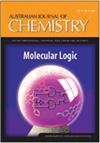5-乙基-1,3,3-三甲基- 3h -吲哚配体在分子材料中的应用评价
IF 0.9
4区 化学
Q4 CHEMISTRY, MULTIDISCIPLINARY
引用次数: 0
摘要
用有机金属基团修饰共轭有机化合物可以调制此类化合物的电子和光电子性质,并使其适用于各种材料应用。有机金属配合物[M(Cp ')(L)n] (M = Ru或Fe;Cp′=环戊二烯(Cp)或五甲基环戊二烯(Cp*);(L)n = (PPh3)2或1,2-双(二苯基膦)乙烷(dppe))和[M(L)n] (M = Ru;(L)n = (dppe)2或(P(OEt)3)4;或M = Pt;制备了(L)n = (PEt3)2, (PPh3)2或用5-乙基-1,3,3-三甲基- 3h -吲哚配体修饰的三环己基膦,(PCy3)2,并通过NMR, IR和单晶x射线衍射对其进行了表征。钌体系的循环伏安法和红外光谱电化学表明,在M-C≡c -芳基部分存在单电子氧化。吲哚配体的n -杂原子表现出路易斯碱性质,能够从偏乙烯中间体中提取一个质子,并与CuI配位。用单分子断结实验也研究了线状化合物的例子,但没有观察到分子结的形成。这很可能是由于这里使用的取代末端吲哚基团与金触点的结合特性。本文章由计算机程序翻译,如有差异,请以英文原文为准。
Evaluation of the 5-ethynyl-1,3,3-trimethyl-3H-indole ligand for molecular materials applications
The modification of conjugated organic compounds with organometallic moieties allows the modulation of the electronic and optoelectronic properties of such compounds and lends them to a variety of material applications. The organometallic complexes [M(Cp′)(L)n] (M = Ru or Fe; Cp′ = cyclopentadiene (Cp) or pentamethylcyclopentadiene (Cp*); (L)n = (PPh3)2 or 1,2-bi(diphenylphosphino)ethane (dppe)) and [M(L)n] (M = Ru; (L)n = (dppe)2 or (P(OEt)3)4; or M = Pt; (L)n = (PEt3)2, (PPh3)2 or tricyclohexylphosphine, (PCy3)2) modified with a 5-ethynyl-1,3,3-trimethyl-3H-indole ligand were prepared and characterised by NMR spectroscopy, IR and single-crystal X-ray diffraction. Cyclic voltammetry and IR spectroelectrochemistry of the ruthenium systems showed a single-electron oxidation localised over the M–C≡C–aryl moiety. The N-heteroatom of the indole ligand showed Lewis base properties and was able to extract a proton from a vinylidene intermediate as well as coordinate to CuI. Examples from the wire-like compounds were also studied by single-molecule break junction experiments but molecular junction formation was not observed. This is most likely attributable to the binding characteristics of the substituted terminal indole groups used here to the gold contacts.
求助全文
通过发布文献求助,成功后即可免费获取论文全文。
去求助
来源期刊

Australian Journal of Chemistry
化学-化学综合
CiteScore
2.50
自引率
0.00%
发文量
65
审稿时长
1.3 months
期刊介绍:
Australian Journal of Chemistry - an International Journal for Chemical Science publishes research papers from all fields of chemical science. Papers that are multidisciplinary or address new or emerging areas of chemistry are particularly encouraged. Thus, the scope is dynamic. It includes (but is not limited to) synthesis, structure, new materials, macromolecules and polymers, supramolecular chemistry, analytical and environmental chemistry, natural products, biological and medicinal chemistry, nanotechnology, and surface chemistry.
Australian Journal of Chemistry is published with the endorsement of the Commonwealth Scientific and Industrial Research Organisation (CSIRO) and the Australian Academy of Science.
 求助内容:
求助内容: 应助结果提醒方式:
应助结果提醒方式:


